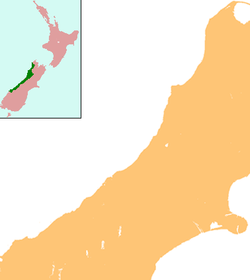Summerlea, New Zealand
Summerlea | |
|---|---|
| Coordinates: 41°31′49″S 171°56′32″E / 41.53028°S 171.94222°E | |
| Country | New Zealand |
| Region | West Coast |
| District | Buller District |
Summerlea is a lightly populated locality[1] on the West Coast of New Zealand's South Island.
Summerlea is on the Tasman Sea coastline with the Glasgow Range to the east. To the north of the town is the neighbouring settlement of Mokihinui and the rivermouth of the Mokihinui River. State Highway 67 passes through the locality. It is included in the Mokihinui statistical area by Statistics New Zealand, and at the 2006 New Zealand census, the whole area had a population of 174, a decrease of 7.4% or 12 people since the 1996 census.[2]
In the early 1890s, a branch line railway was opened from Westport through Summerlea, opening to Seddonville on 23 February 1895 and thus acquiring the name of the Seddonville Branch. Passenger services were provided to Summerlea by mixed trains until 14 October 1946, when the line became freight-only. Coal was almost the sole traffic on the line from this point, and when coal mining activity declined in the 1970s, the line's maintenance costs came to outweigh revenue. Accordingly, the line closed beyond Ngakawau on 3 May 1981, and much of the line's formation can still be seen passing through the countryside around Summerlea.[3]
References
- ^ "Place name detail: Summerlea". New Zealand Gazetteer. New Zealand Geographic Board. Retrieved 24 June 2007.
- ^ Quickstats about Mokihinui
- ^ David Leitch and Brian Scott, Exploring New Zealand's Ghost Railways, rev. ed. (Wellington: Grantham House, 1998), 52-4.

